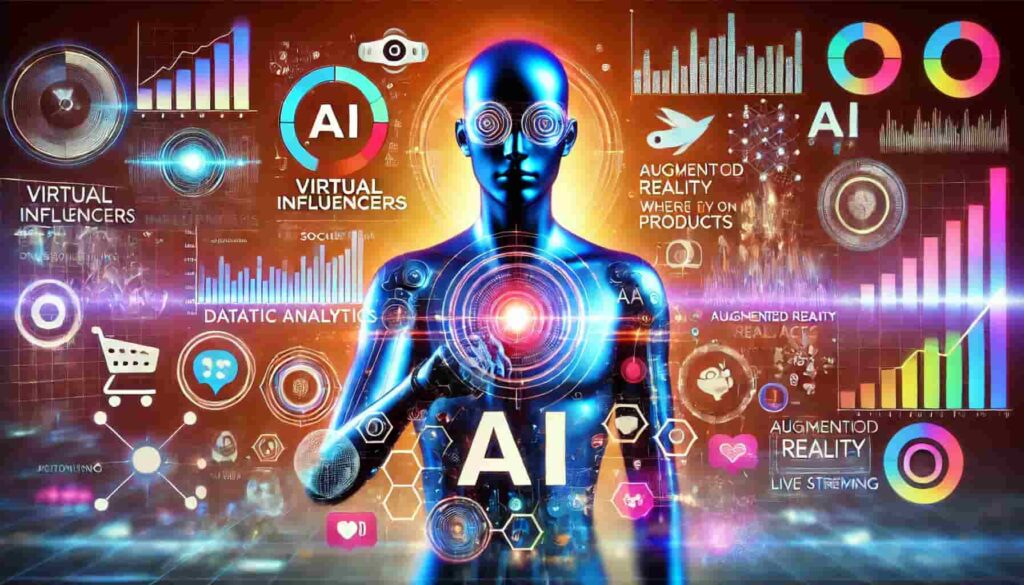In today’s fast-changing digital marketing world, a new concept called “influencersginewuld” transforms how brands engage with their audiences. This innovative approach combines advanced technology, like AI and augmented reality, with influencer marketing to create more personalized and interactive experiences.
By using virtual influencers and data-driven strategies, brands can connect with consumers in more meaningful ways. In this guide, we’ll explore how influencersginewuld is changing the marketing landscape, its key technologies, benefits, ethical concerns, and its potential to revolutionise brand-consumer relationships.
What Is Influencersginewuld?
Influencersginewuld refers to the integration of cutting-edge technology with influencer marketing to create a new, enhanced form of consumer engagement. The term encapsulates the use of AI, AR, and virtual influencers to develop highly personalized, immersive campaigns that go beyond traditional influencer strategies.
Unlike standard influencer marketing, which relies on human influencers to create and share content, Influencersginewuld leverages virtual personas, advanced data analytics, and interactive technology to drive deeper, more meaningful consumer interactions.
The Evolution Of Influencer Marketing:
Influencer marketing has come a long way since the early days of blogging and social media endorsements. What started as individuals sharing their passions online has transformed into a multi-billion-dollar industry, where influencers have the power to shape brand identities and drive consumer behaviour.
However, as consumer expectations shift, brands are exploring new ways to capture attention. Traditional influencer marketing—focused primarily on visibility and engagement—has its limitations. Consumers today demand more personalized, authentic experiences. This is where Influencersginewuld come into play, blending technology with creativity to deliver marketing campaigns that feel more tailored, engaging, and impactful.
Key Components Of Influencersginewuld – Let’s See!
Virtual Influencers:
Virtual influencers are computer-generated characters that have carved out a substantial online presence. These digital personas, such as the well-known Lil Miquela, serve as powerful tools for brands, delivering consistent and creative messaging.
- Controlled Messaging and Brand Alignment: Brands can craft a narrative that aligns perfectly with their identity and values, minimizing the risks associated with human influencers.
- 24/7 Availability for Content Creation: Virtual influencers are always on, allowing for constant engagement and content generation without the limitations of human schedules.
- Elimination of Human-Related Controversies: Without personal lives or controversies, these avatars maintain a stable brand image, free from unexpected public relations challenges.
- Appeal to Tech-Savvy Audiences: Virtual influencers resonate with younger, digitally native consumers who appreciate innovation and creativity.
AI-Driven Personalization:
Artificial Intelligence is a cornerstone of Influencersginewuld, enabling brands to create highly personalized content for their audiences. By analyzing extensive user data, AI systems can:
- Adjust Campaign Elements in Real-Time: AI algorithms can modify aspects of a campaign based on immediate feedback, ensuring maximum effectiveness.
- Predict User Preferences and Behaviors: By analyzing past interactions, AI can anticipate what content will resonate most with specific user segments.
- Create Personalized Content Recommendations: AI systems deliver tailored suggestions for products or content that align with individual user interests.
- Optimize Campaign Performance Based on Engagement Metrics: Real-time analysis allows for adjustments that enhance engagement and conversion rates throughout the campaign lifecycle.

Augmented Reality (AR):
AR technology takes influencer marketing beyond traditional boundaries, transforming passive content consumption into interactive experiences. With AR, users can:
- Virtually Try-On Products: Consumers can experiment with makeup, clothing, and accessories in a virtual setting before making a purchase.
- Visualize Items in Their Own Space: AR allows users to see how furniture or decor would look in their homes, enhancing the buying experience.
- Engage with Branded Filters and Effects: Users can interact with custom filters on social media, increasing brand visibility and engagement.
- Participate in Immersive Brand Storytelling: AR creates a narrative experience that draws consumers deeper into the brand’s world, making interactions more memorable.
Data Analytics:
Data analytics is vital for the success of Influencersginewuld, providing brands with actionable insights that inform marketing strategies. Key aspects include:
- In-Depth Audience Segmentation: Brands can categorize audiences based on behaviour, preferences, and demographics, allowing for highly targeted marketing efforts.
- Campaign Performance Tracking: Analytics tools help monitor key performance indicators (KPIs) in real time, allowing brands to adjust tactics promptly.
- Identifying Emerging Trends: By analyzing data, brands can stay ahead of market trends, tailoring their campaigns to meet changing consumer demands.
Interactive Content:
Interactive content is another crucial component of Influencersginewuld, enhancing user engagement and driving deeper connections with brands. This includes:
- Quizzes and Polls: Engaging users through quizzes or polls encourages participation and provides valuable data about preferences.
- Gamification Elements: Incorporating game-like features into marketing strategies can enhance user interaction and encourage loyalty.
- Live Streaming and Real-Time Interaction: Brands can use live video to engage directly with their audience, allowing for instant feedback and connection.
The Role Of Technology In Influencersginewuld – You Must Read!
The Influencersginewuld concept relies heavily on advancements in technology. AI, machine learning, and data analytics play a central role in creating personalized, efficient, and scalable influencer campaigns.
Artificial Intelligence (AI):
AI is pivotal in enabling brands to go beyond generalized messaging and tap into consumer-specific preferences. It analyzes vast amounts of data to understand individual consumer behaviour and makes recommendations in real-time. This allows brands to create more personalized and effective marketing strategies.
Machine Learning (ML):
Machine learning (ML) is the engine that powers continuous improvement in Influencersginewuld. As ML algorithms collect data on how consumers interact with content, they learn from these interactions to enhance future campaigns. This ongoing process allows for smarter, more intuitive influencer marketing strategies.
Data Analytics:
Data analytics is the backbone of personalized marketing. By gathering and analyzing data on consumer behaviour, preferences, and engagement, brands can refine their strategies to achieve better results. In Influencersginewuld, data is used not only to personalize content but also to track the effectiveness of campaigns in real time.
The Impact Of Influencersginewuld On Digital Marketing – Need To Know!
The emergence of influencersginewuld is transforming digital marketing in significant ways. By combining advanced technologies like AI, AR, and virtual influencers, brands can create marketing campaigns that are more engaging and personalized than ever before. This approach allows businesses to connect with their audiences on a deeper level, making interactions feel more relevant and tailored.
As a result, consumers are more likely to engage with content that resonates with their interests and needs. Additionally, the use of data analytics helps brands understand their audience better, enabling smarter decisions that lead to higher conversion rates. Overall, influencersginewuld is changing the landscape of marketing, making it more interactive and effective.
Implementing Influencersginewuld – Strategies For Success!
To effectively harness the power of influencersginewuld, brands should consider the following strategies:
- Identify the Right Virtual Influencers: Research and select virtual influencers that align with your brand’s values and target audience. Look for characters that resonate with your market demographic and can convey your messaging authentically.
- Leverage Data-Driven Insights: Utilize data analytics tools to gather insights on audience behaviour and preferences. This information will guide your content strategy and help tailor campaigns to meet specific user needs, ensuring higher engagement rates.
- Incorporate Augmented Reality Experiences: Integrate AR features into your marketing campaigns to provide interactive experiences for consumers. Allow users to virtually try on products or visualize items in their environment, enhancing their overall engagement with your brand.
- Embrace AI for Personalization: Implement AI-driven tools to create personalized content that adapts to individual user preferences. This level of customization can significantly enhance user experience and foster a deeper connection with your audience.
- Focus on Transparency and Authenticity: While using virtual influencers, maintain transparency with your audience regarding sponsored content and brand partnerships. Building trust is crucial, so ensure that your campaigns reflect authenticity and ethical standards to resonate positively with consumers.

The Future Of Influencersginewuld:
The future of influencersginewuld promises to be an exciting evolution in the digital marketing landscape. As technology continues to advance, we can expect even greater integration of artificial intelligence and augmented reality, allowing brands to create more immersive and personalized experiences for consumers. Virtual influencers are likely to gain more prominence, serving as consistent and controlled brand ambassadors that resonate with tech-savvy audiences.
Enhanced data analytics will enable brands to refine their strategies in real time, ensuring campaigns are not only relevant but also highly effective. Additionally, as ethical considerations grow in importance, brands will need to prioritize transparency and authenticity to maintain consumer trust. Overall, influencersginewuld is poised to transform how brands engage with their audiences, driving deeper connections and more impactful marketing outcomes.
FAQs:
What are the benefits of using augmented reality in influencer campaigns?
Augmented reality creates interactive experiences, letting consumers try products virtually. This engagement enhances brand interaction and makes it more memorable. AR helps consumers make informed decisions by visualizing products in their environments.
How can brands measure the success of influencersginewuld campaigns?
Brands can track engagement rates, time spent on AR content, and conversion rates from virtual try-ons. Analyzing brand sentiment and comparing ROI with traditional methods provides further insights. These metrics help assess the effectiveness of campaigns.
Are there ethical concerns related to influencersginewuld?
Yes, ethical questions arise around transparency and authenticity with virtual influencers. Consumers may be misled by idealized digital personas that don’t reflect reality. Brands must address these concerns to maintain trust and credibility.
How do virtual influencers differ from human influencers?
Virtual influencers are computer-generated characters, unlike human influencers who are real people. They provide brands with consistent messaging and creative control, free from human controversies. This allows for a more reliable and appealing representation of brand values.
What challenges do brands face when adopting influencersginewuld?
Brands may face challenges in adapting to new technologies and selecting appropriate virtual influencers. Interpreting complex data analytics can also be difficult. Strategic planning and a willingness to innovate are essential to overcome these challenges.
How can brands ensure transparency in their influencersginewuld campaigns?
Brands can promote transparency by disclosing partnerships with virtual influencers. Clear communication about the content creation process fosters trust with consumers. Transparency is crucial to address ethical concerns in influencer marketing.
Conclusion:
influencersginewuld represents a significant shift in how brands connect with consumers by integrating advanced technologies like AI and AR. This innovative approach allows for personalized and immersive marketing experiences that engage audiences more effectively.
As virtual influencers gain popularity, they offer brands greater control and consistency in messaging. Ultimately, influencersginewuld is paving the way for the future of digital marketing, making it more dynamic and interactive.
You Have To Read:

